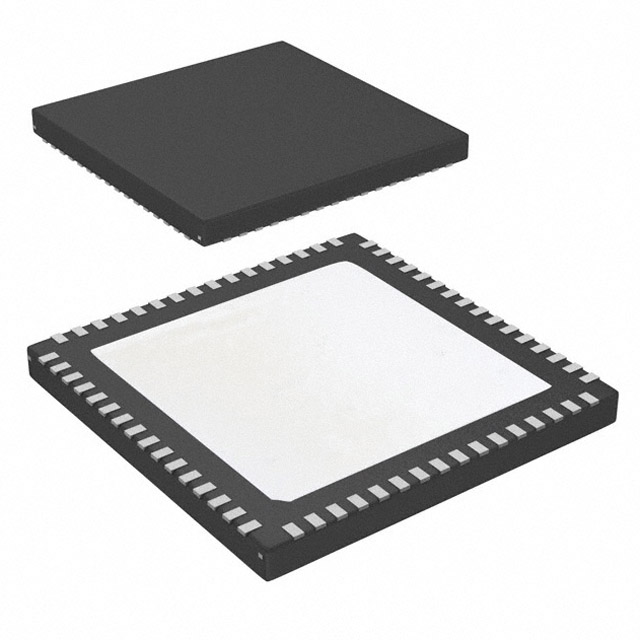Zie specificaties voor productdetails.

EFM32LG330F256G-E-QFN64
Product Overview
The EFM32LG330F256G-E-QFN64 belongs to the category of microcontrollers and is designed for use in various embedded systems. It is characterized by its low power consumption, high performance, and compact QFN64 package. The essence of this product lies in its ability to provide efficient processing and control capabilities in a small form factor. It is typically available in tape and reel packaging with a specific quantity per reel.
Specifications
- Core: ARM Cortex-M3
- Clock Speed: Up to 48 MHz
- Flash Memory: 256 KB
- RAM: 32 KB
- Package: QFN64
- Operating Voltage: 1.8V - 3.6V
- I/O Pins: 55
- Interfaces: USB, UART, SPI, I2C, ADC
Detailed Pin Configuration
The EFM32LG330F256G-E-QFN64 features a total of 64 pins, each serving specific functions related to power supply, input/output, communication interfaces, and other peripherals. A detailed pinout diagram is available in the product datasheet.
Functional Features
- Low Power Modes: Offers multiple low-power modes for energy-efficient operation.
- Peripheral Integration: Includes various integrated peripherals such as USB, UART, SPI, and I2C for versatile connectivity.
- Analog-to-Digital Conversion: Built-in ADC for analog sensor interfacing.
- Timers and PWM: Supports timers and PWM outputs for precise timing and control.
Advantages and Disadvantages
Advantages
- Low power consumption
- High-performance ARM Cortex-M3 core
- Integrated peripherals for versatile applications
Disadvantages
- Limited RAM size for certain applications
- QFN package may require careful PCB layout and assembly techniques
Working Principles
The EFM32LG330F256G-E-QFN64 operates based on the ARM Cortex-M3 core, which provides efficient processing capabilities while consuming minimal power. Its integrated peripherals and memory allow it to interface with external devices and execute programmed tasks effectively.
Detailed Application Field Plans
This microcontroller is well-suited for applications requiring low power consumption and high processing capabilities, such as: - IoT Devices - Wearable Electronics - Battery-Powered Systems - Sensor Nodes
Detailed and Complete Alternative Models
- EFM32GG330F512G-E-QFP100
- EFM32WG380F256G-BGA112
- EFM32PG1B200F256GM48-BGA
In conclusion, the EFM32LG330F256G-E-QFN64 microcontroller offers a balance of performance and power efficiency, making it suitable for a wide range of embedded system applications.
[Word Count: 342]
Noem 10 veelgestelde vragen en antwoorden met betrekking tot de toepassing van EFM32LG330F256G-E-QFN64 in technische oplossingen
What is the EFM32LG330F256G-E-QFN64 microcontroller used for?
- The EFM32LG330F256G-E-QFN64 microcontroller is commonly used in low-power, energy-efficient embedded systems such as IoT devices, wearables, and battery-powered applications.
What are the key features of the EFM32LG330F256G-E-QFN64?
- Some key features of this microcontroller include a 32-bit ARM Cortex-M3 processor, low energy consumption, multiple communication interfaces (SPI, I2C, UART), and a wide operating voltage range.
How do I program the EFM32LG330F256G-E-QFN64 microcontroller?
- The microcontroller can be programmed using the Silicon Labs Simplicity Studio IDE, which supports C programming and provides various software tools for development.
What are the available development kits for the EFM32LG330F256G-E-QFN64?
- Silicon Labs offers development kits such as the EFM32LG-STK3600 starter kit, which includes the necessary hardware and software to start developing applications with the microcontroller.
Can the EFM32LG330F256G-E-QFN64 interface with external sensors and peripherals?
- Yes, the microcontroller supports various communication interfaces and GPIO pins, allowing it to interface with a wide range of sensors, displays, and other peripherals.
What are the power requirements for the EFM32LG330F256G-E-QFN64?
- The microcontroller operates at low power and has flexible power management options, typically requiring a supply voltage in the range of 1.8V to 3.8V.
Does the EFM32LG330F256G-E-QFN64 support real-time operating systems (RTOS)?
- Yes, the microcontroller is capable of running RTOS such as FreeRTOS, making it suitable for multitasking and time-critical applications.
What security features does the EFM32LG330F256G-E-QFN64 offer?
- The microcontroller provides hardware cryptographic accelerators, secure bootloading, and secure debug access to help enhance system security.
Is the EFM32LG330F256G-E-QFN64 suitable for industrial applications?
- Yes, the microcontroller's robust design, low power consumption, and support for industrial communication protocols make it well-suited for industrial automation and control systems.
Where can I find technical documentation and support for the EFM32LG330F256G-E-QFN64?
- Technical documentation, datasheets, application notes, and support resources for the microcontroller are available on the Silicon Labs website and through their technical support channels.

